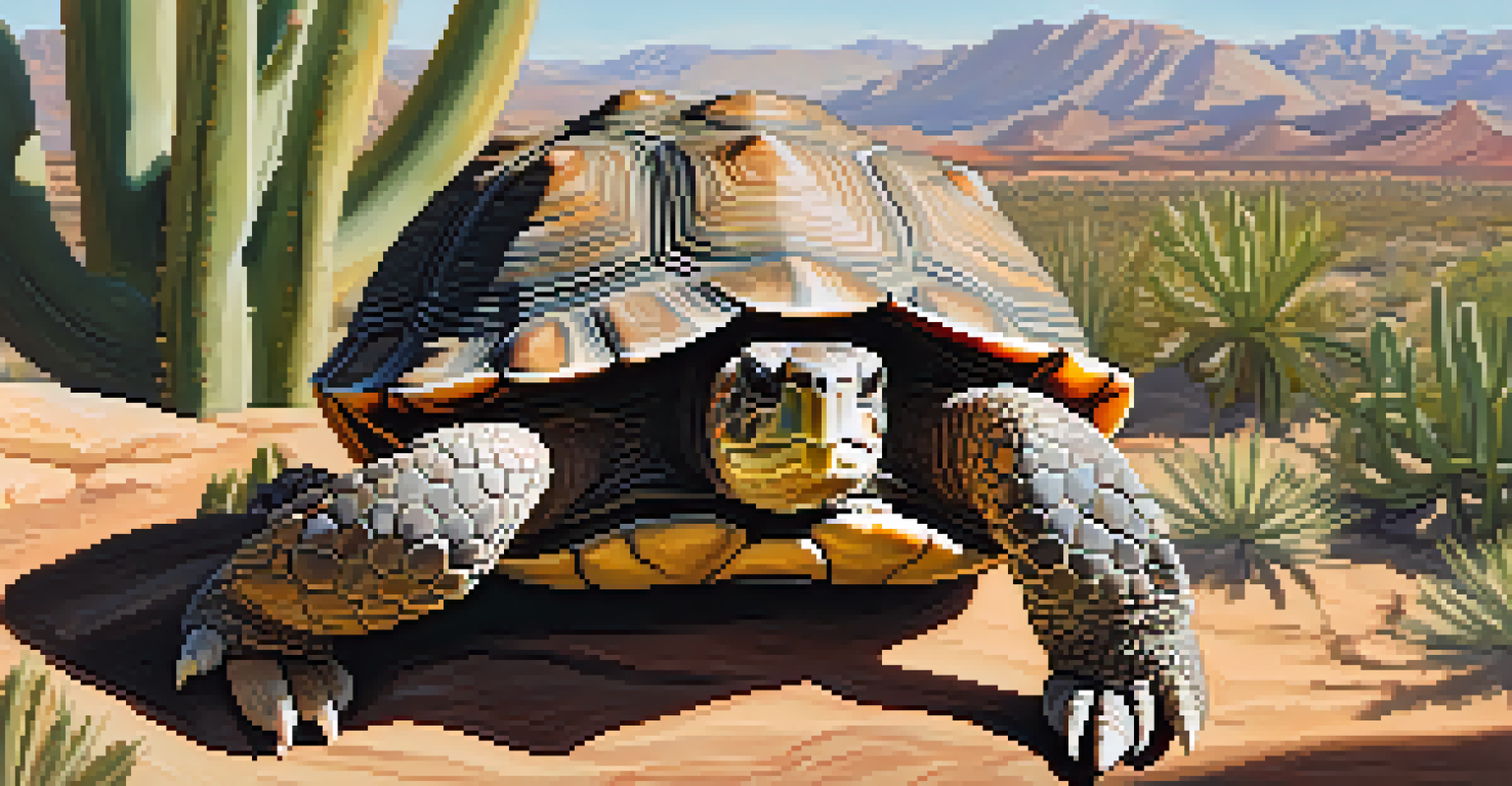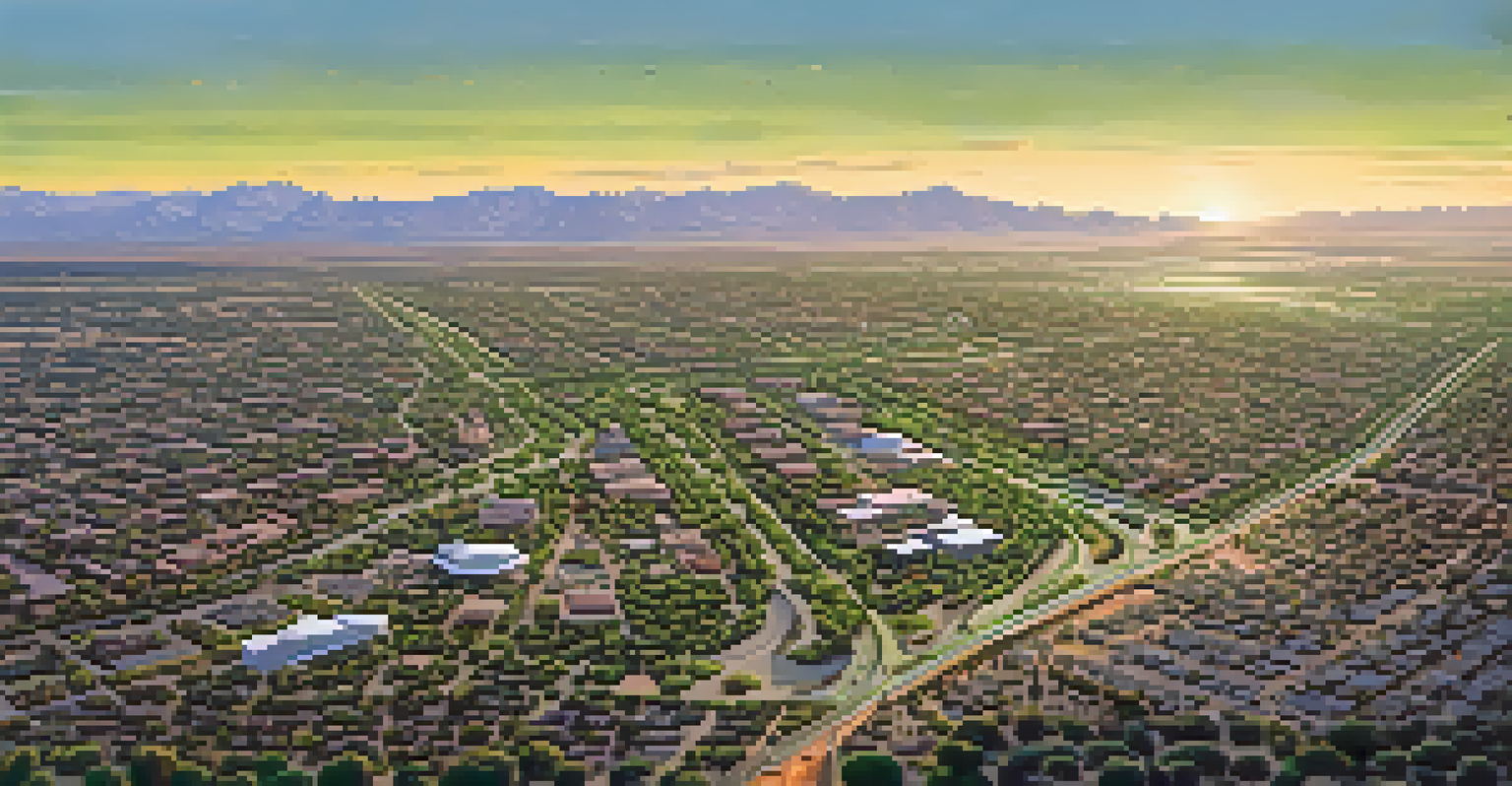Urbanization Effects on Arizona Wildlife: A Comprehensive Study

Understanding Urbanization and Its Rapid Growth in Arizona
Urbanization refers to the increasing number of people living in urban areas, a trend that has been rapidly growing in Arizona. As cities expand, they transform landscapes, often at the expense of natural habitats. Arizona's stunning deserts and mountains are no exception, as urban sprawl continues to encroach upon these ecosystems.
The environment is where we all meet; where we all have a mutual interest; it is the only thing we all share.
The influx of residents and businesses leads to significant changes in land use, which can fragment wildlife habitats. For instance, areas once home to diverse species may become congested neighborhoods or commercial zones. This rapid change poses significant challenges for local wildlife, who are often ill-equipped to adapt to such swift alterations in their environment.
In this dynamic landscape, understanding the effects of urbanization is essential. By examining how these changes affect wildlife, we can identify strategies to mitigate negative impacts and promote coexistence between nature and urban development.
Direct Impacts of Urbanization on Wildlife Populations
One of the most immediate effects of urbanization on wildlife is habitat loss, which can lead to population declines. Species like the desert tortoise and various bird species are particularly vulnerable as their habitats shrink. In many cases, animals are forced to migrate to less suitable areas, which can disrupt their breeding and feeding patterns.

Urban areas also introduce new threats to wildlife, such as increased vehicle traffic, predation from domestic animals, and competition for resources. For example, coyotes, once primarily found in remote areas, are now commonly seen in urban settings, adapting to their new environment but facing dangers like road collisions.
Urbanization Threatens Wildlife Habitats
As urban areas expand in Arizona, natural habitats are lost, leading to significant challenges for local wildlife.
Additionally, urbanization can alter the natural food chain, leading to imbalances in ecosystems. When certain species decline, it can have ripple effects on others, causing a decline in biodiversity and altering the ecological fabric of the region.
Fragmentation of Habitats: A Growing Concern
Habitat fragmentation occurs when large habitats are divided into smaller, isolated patches, often due to urban development. This fragmentation can severely impact species that require extensive territories for foraging, breeding, and migration. For example, large mammals like mountain lions may struggle to find mates or adequate food sources when their ranges are cut off by roads and buildings.
In nature, nothing exists alone.
Moreover, fragmented habitats can lead to 'edge effects,' which alter the conditions of the remaining habitat. These changes can expose wildlife to predators and human activities, further threatening their survival. As a result, many species find it challenging to thrive in these altered landscapes.
Addressing habitat fragmentation is crucial for preserving Arizona's wildlife. By creating wildlife corridors and protected areas, we can help maintain connectivity between habitats, allowing animals to move freely and adapt to changing conditions.
The Role of Climate Change in Urban Wildlife Dynamics
Climate change adds another layer of complexity to the effects of urbanization on wildlife. As temperatures rise and weather patterns shift, many species face additional stressors that can compound the challenges posed by urban environments. For instance, some animals may struggle to find suitable shelter or food sources as their habitats are altered.
Urban areas can also create 'heat islands,' where temperatures are significantly higher than surrounding rural areas. This phenomenon can exacerbate the effects of climate change, making it even harder for wildlife to adapt. Species that are already sensitive to temperature changes, like amphibians, may face dire consequences.
Habitat Fragmentation Impacts Species
Fragmentation of habitats due to urban development disrupts the movement and survival of species like mountain lions.
Understanding the intersection of urbanization and climate change is essential for wildlife conservation efforts. By recognizing how these factors interact, we can develop more effective strategies to support wildlife adaptability and resilience.
Human-Wildlife Interactions in Urban Settings
As urban areas expand into wildlife habitats, interactions between humans and animals become more common. While some may see these encounters as exciting, they can lead to conflicts that endanger both parties. For example, raccoons rummaging through trash cans may be a nuisance, leading some residents to take extreme measures to deter them.
Promoting coexistence is vital to reducing these conflicts. Education plays a key role in helping communities understand the importance of wildlife and how to coexist peacefully. Simple actions, like securing trash or using wildlife-friendly fencing, can make a significant difference.
Encouraging respectful interactions with wildlife not only protects animals but also enriches the community. By fostering a sense of appreciation for Arizona's unique wildlife, residents can contribute to a healthier coexistence between nature and urban life.
Conservation Efforts Addressing Urbanization Challenges
In response to the challenges posed by urbanization, various conservation efforts are taking shape across Arizona. Organizations are working to create wildlife corridors that connect fragmented habitats, ensuring animals can move safely between areas. These projects highlight the importance of collaboration between government, conservationists, and local communities.
Additionally, urban planning initiatives are increasingly incorporating green spaces and natural habitats into city designs. Parks, wildlife reserves, and native landscaping can provide essential refuges for local wildlife, while also enhancing the quality of life for residents.
Sustainable Planning Supports Wildlife
Engaging in sustainable urban planning can help balance development needs with wildlife conservation efforts.
By supporting and participating in these conservation initiatives, individuals can play a role in promoting biodiversity in urban settings. Every small effort contributes to a larger movement aimed at preserving Arizona's unique wildlife heritage.
Future Directions: Sustainable Urban Planning and Wildlife
Looking ahead, sustainable urban planning will be crucial in balancing development with wildlife conservation. By integrating ecological considerations into city designs, planners can minimize the negative impacts of urbanization on local ecosystems. This approach fosters a more harmonious relationship between people and nature.
Incorporating green infrastructure, such as green roofs, permeable pavements, and urban forests, can help mitigate the effects of urbanization. These features not only support wildlife but also improve air quality and reduce the urban heat island effect, benefiting residents as well.

Ultimately, the future of Arizona's wildlife depends on our collective commitment to thoughtful and sustainable development. By prioritizing both human and wildlife needs, we can pave the way for a more balanced coexistence in our growing urban landscapes.